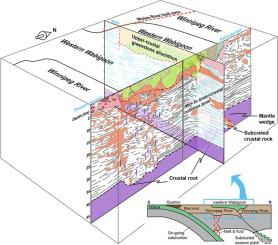Precambrian Research ( IF 3.8 ) Pub Date : 2021-08-19 , DOI: 10.1016/j.precamres.2021.106339 Chong Ma 1 , Mostafa Naghizadeh 1 , Ademola Adetunji 1 , Robert W.D. Lodge 2 , David Snyder 1 , Ross Sherlock 1

|
The Neoarchean is considered as a pivotal era during the Earth’s evolution in terms of cratonization and development of plate tectonics. The supporting crustal processes, however, remain elusive due in part to limited comprehensive imaging of crustal structures underlying Neoarchean terranes. This study uses new seismic, magnetotelluric, and geologic data from the Metal Earth Sturgeon transect (70 km) and existing seismic and aeromagnetic data to investigate the Neoarchean crustal architecture underlying the greenstone-dominated western Wabigoon terrane (WWT) and the tonalite-trondhjemite-granodiorite-dominated Winnipeg River terrane (WRT) of the Superior craton. The results suggest that (1) the Sturgeon Lake greenstone belt of the WWT is 5–10 km thick and separated by a thrust fault from the underlying basement, (2) the basement is characterized by gneissic fabrics from the mid- to lower-crust of probable Paleo to Mesoarchean WRT rocks, and that (3) the crust was extensively reworked by Neoarchean post-tectonic magmatism that was characterized by carbon- and/or hydrogen-rich silicates and likely caused by partial melting of mantle/crustal rocks triggered by subduction-related fluids/melts. With the reprocessed Lithoprobe seismic data from the same region, a 3D crustal architecture is reconstructed and reveals a convergent belt between the main WRT to the north and a continental margin promontory of the WRT to the south. This Neoarchean convergent belt is characterized by an allochthonous greenstone belt as a thrust sheet in the upper crust, a collision zone in the mid- to lower-crust, an apparent crustal root of 3–5 km relief, and subcreted crustal rocks beneath a mantle wedge. Published data suggest that an outboard, north-dipping subduction zone associated with the Wawa terrane provided the fluids/melts for the post-tectonic magmatism in the WRT-WWT crust. This study favors a model of subduction followed by collision over a collision-only model, which indicates that multiple subduction zones were operative synchronously in a period during the assembly of the western Superior craton. Cratonization by accretionary orogenesis due to plate tectonics in the Neoarchean, therefore, is imaged and characterized in this study using a 3D crustal architecture.
中文翻译:

成像新太古代地壳结构:西部瓦比贡和温尼伯河地体的综合地质-地震-大地电磁研究,上克拉通
就克拉通化和板块构造发展而言,新太古代被认为是地球演化过程中的关键时期。然而,支持地壳过程仍然难以捉摸,部分原因是对新太古代地体下地壳结构的综合成像有限。本研究使用来自金属地球鲟鱼断面(70 公里)的新地震、大地电磁和地质数据以及现有的地震和航磁数据来研究以绿岩为主的西瓦比贡地体 (WWT) 和辉长岩-长闪长岩的新太古代地壳结构。上级克拉通以花岗闪长岩为主的温尼伯河地体 (WRT)。结果表明:(1) WWT 的 Sturgeon Lake 绿岩带厚 5-10 km,被逆冲断层与下伏基底隔开,(2) 基底以可能古至中太古代 WRT 岩石中下地壳的片麻岩织物为特征,(3) 地壳受到新太古代后构造岩浆作用的广泛改造,其特征是碳和/或富含氢的硅酸盐,可能是由俯冲相关流体/熔体引发的地幔/地壳岩石部分熔化引起的。使用来自同一地区的重新处理的 Lithoprobe 地震数据,重建了 3D 地壳结构,并揭示了北部主要 WRT 和南部 WRT 大陆边缘海角之间的会聚带。这条新太古代会聚带的特征是上地壳为逆冲片的外来绿岩带,中下地壳为碰撞带,地壳根部有明显的3-5公里起伏,和地幔楔下的地壳岩石。已发表的数据表明,一个与 Wawa 地体相关的外侧北倾俯冲带为 WRT-WWT 地壳中的后构造岩浆活动提供了流体/熔体。这项研究支持俯冲后碰撞模型,而不是仅碰撞模型,这表明多个俯冲带在一个时期内同步运行 在西苏必利尔克拉通的组装过程中。因此,本研究使用 3D 地壳结构对由于新太古代板块构造引起的增生造山作用造成的克拉通化进行了成像和表征。



























 京公网安备 11010802027423号
京公网安备 11010802027423号